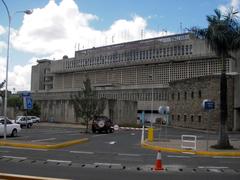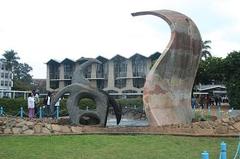
Visiting Hours, Tickets, and Historical Insights of Uhuru Gardens, Nairobi
Date: 16/08/2024
Introduction
Uhuru Gardens, nestled in the bustling city of Nairobi, Kenya, stands as a monumental testament to the nation’s rich history and profound journey towards independence. Officially inaugurated on May 10, 1969, by Kenya’s first President, Jomo Kenyatta, the gardens were established to commemorate the struggle and eventual triumph of the Kenyan people over British colonial rule (Kahawa Tungu). The name ‘Uhuru,’ translating to ‘freedom’ in Swahili, encapsulates the essence of the park’s historical significance. Visitors to Uhuru Gardens are greeted by the iconic Freedom Monument, a towering 24-meter-high structure symbolizing the joy and hope that accompanied Kenya’s independence on December 12, 1963 (Kahawa Tungu). This park is not merely a recreational space but a vibrant tapestry of Kenya’s past, present, and future, offering a unique blend of historical landmarks, environmental conservation efforts, and cultural festivities. Whether you’re a history enthusiast, a nature lover, or a casual visitor, Uhuru Gardens provides a rich, immersive experience that reflects the spirit and resilience of the Kenyan people.
Table of Contents
- Inception and Historical Context
- The Freedom Monument
- The Union Jack and the Kenyan Flag
- The Mugumo Tree
- Monuments and Sculptures
- National Celebrations and Commemorations
- Environmental Conservation
- The Future of Uhuru Gardens
- Visitor Experience
- Visitor Information
- Special Events and Guided Tours
- FAQ
Discover the History and Visiting Tips for Uhuru Gardens in Nairobi
Inception and Historical Context
Uhuru Gardens, located in Nairobi, Kenya, is a site of profound historical significance. The name “Uhuru” translates to “freedom” in Swahili, symbolizing the park’s deep connection to Kenya’s struggle for independence. The gardens were officially inaugurated on May 10, 1969, by Kenya’s first President, Jomo Kenyatta, to commemorate the nation’s hard-fought journey to sovereignty (Kahawa Tungu).
The Freedom Monument
At the heart of Uhuru Gardens stands the iconic Freedom Monument, a 24-meter-high structure unveiled during the park’s inauguration. This monument is a powerful symbol of the joy and hope that accompanied Kenya’s independence from British colonial rule on December 12, 1963. The statue depicts a man, woman, and child proudly raising the Kenyan flag, representing the unity and shared dreams of the nation (Kahawa Tungu).
The Union Jack and the Kenyan Flag
Uhuru Gardens holds a prominent place in Kenyan history as the site where the Union Jack, the British flag, was lowered, and the Kenyan flag was raised for the first time on December 12, 1963. This momentous event marked Kenya’s independence and the dawn of a new era. The event is immortalized in a black and white film reel widely screened on Jamhuri and Madaraka days (The East African).
The Mugumo Tree
Within the gardens, a Mugumo (fig) tree was planted on the exact spot where the Union Jack was brought down and the Kenyan flag was first hoisted. This tree symbolizes the end of colonial oppression and the beginning of Kenya’s journey of freedom. The Mugumo tree is a significant landmark, representing the historical moment when Kenya was born as an independent nation (Google Arts & Culture).
Monuments and Sculptures
Uhuru Gardens is home to several monumental landmarks that commemorate Kenya’s independence and the spirit of its people. The 1973 Independence Day Monument, a 24-meter column, marks 20 years since Kenya’s independence. At the base of the column, a pair of marble hands clasp a heart with a dove hovering above, symbolizing the Nyayo philosophy of ‘Peace, Love, and Unity.’ To the right of the tower, a woman and three men raise the Kenyan flag in the spirit of togetherness or ‘Harambee.’ To the left, the statue of a man stands in front of the Kenya Court of Arms, ready to ‘protect our interests and resources’ (Kenya Geographic).
Another significant monument is the 25th-anniversary monument erected in 1987 to mark 25 years since independence. It depicts three people pushing against a marble prism and a column towering above them, symbolizing the unity and resilience of the Kenyan people (Google Arts & Culture).
National Celebrations and Commemorations
Throughout the year, Uhuru Gardens becomes a focal point for national celebrations, memorials, and cultural festivals. Kenyans gather here to commemorate significant historical events and mark important national holidays, instilling a sense of unity and pride among its people. The gardens are especially significant during Jamhuri Day (Independence Day) and Madaraka Day, where the historical events of December 12, 1963, are remembered and celebrated (Kahawa Tungu).
Environmental Conservation
Uhuru Gardens also plays a vital role in environmental conservation. The park’s beautiful green spaces and variety of flora and fauna contribute to urban biodiversity and make it a vital green lung within Nairobi. The park is home to numerous bird species and provides an essential habitat for local wildlife. These conservation efforts ensure that the gardens remain a serene and ecologically significant space within the bustling city (Kahawa Tungu).
The Future of Uhuru Gardens
Uhuru Gardens continues to evolve, with ongoing efforts to maintain its historical relevance and ecological importance. The Kenya Defence Forces have been instrumental in the development and maintenance of the gardens, ensuring that they remain a symbol of national pride and a place for reflection and celebration. The gardens are now a National Monument and Museum, with a public arena that hosts various events and activities, making it a vibrant cultural and recreational hub (Ole Sereni).
Visitor Experience
For visitors, Uhuru Gardens offers a rich historical and cultural experience. The well-manicured lawns provide an ideal location for picnics, and the park is a popular venue for corporate events, concerts, and photoshoots. The gardens are open daily from 8:00 AM to 6:00 PM, and visitors can easily access nearby amenities for snacks and refreshments. The park’s location along Langata Road, near the Uchumi Langata Hyper, makes it convenient for both locals and tourists to visit (Kenya Geographic).
Visitor Information
To make the most of your visit to Uhuru Gardens, here are some essential tips:
- Visiting Hours: Open daily from 8:00 AM to 6:00 PM.
- Tickets: Entry is free, but special events may have associated costs.
- Travel Tips: Located along Langata Road, near the Uchumi Langata Hyper. Easily accessible by public transport or taxi.
- Nearby Attractions: Nairobi National Park, Giraffe Centre, and Karen Blixen Museum.
- Accessibility: The park is wheelchair accessible with paved paths and ramps.
Special Events and Guided Tours
Uhuru Gardens hosts various special events throughout the year, including national celebrations, cultural festivals, and public gatherings. Guided tours are available to provide deeper insights into the historical significance of the monuments and landmarks. Visitors can capture beautiful photos at designated photographic spots within the gardens.
FAQ
Q: What are the visiting hours for Uhuru Gardens?
A: Uhuru Gardens is open daily from 8:00 AM to 6:00 PM.
Q: Is there an entry fee for Uhuru Gardens?
A: Entry is free, but special events may have associated costs.
Q: How can I get to Uhuru Gardens?
A: The gardens are located along Langata Road, near the Uchumi Langata Hyper, and are easily accessible by public transport or taxi.
Q: Are there any nearby attractions?
A: Yes, nearby attractions include Nairobi National Park, Giraffe Centre, and Karen Blixen Museum.
Conclusion and Call to Action
In summary, Uhuru Gardens is not just a park but a living monument to Kenya’s journey to independence and its ongoing commitment to unity, peace, and environmental conservation. It stands as a testament to the resilience and spirit of the Kenyan people, offering a space for reflection, celebration, and community. Plan your visit today and immerse yourself in the rich history and natural beauty of Uhuru Gardens. For more information, follow us on social media and check out our related articles on Nairobi’s historical sites.
Explore Uhuru Gardens: Visiting Hours, Tickets, Activities & More in Nairobi
Conclusion
In conclusion, Uhuru Gardens is far more than a historical site; it is a living monument to Kenya’s enduring spirit of freedom, unity, and environmental stewardship. From the symbolic Freedom Monument and the historically significant Mugumo tree to the serene green spaces that support urban biodiversity, the gardens offer a multifaceted experience for all visitors (Kahawa Tungu; Google Arts & Culture). As a focal point for national celebrations and cultural events, it continues to be a place where Kenyans gather to commemorate their shared history and honor their heroes (Kahawa Tungu). Whether you’re exploring the historical monuments, participating in a guided tour, or simply enjoying a peaceful picnic, Uhuru Gardens promises a memorable visit that blends education, recreation, and reflection. Plan your visit today to immerse yourself in the rich history and natural beauty that Uhuru Gardens has to offer. Stay connected with us through our social media channels and our mobile app, Audiala, for more updates and information on Nairobi’s historical sites.
References
- Kahawa Tungu, 2023, Uhuru Gardens: A Symbol of Kenyan Independence and Heritage
- The East African, 2023, Uhuru Gardens: Kenya Permanent Freedom Museum
- Google Arts & Culture, 2023, Uhuru Gardens
- Kenya Geographic, 2023, Retrace Kenya Freedom: Uhuru Gardens
- Ole Sereni, 2023, 7 Facts About Uhuru Gardens National Monument and Museum
- TripHobo, 2023, Uhuru Gardens Memorial Park
- Travel Picks, 2023, Uhuru Gardens
- Explore254, 2023, Uhuru Gardens
- Enzi Museum, 2023, Museums of Kenya: Monuments
- Holidify, 2023, Uhuru Gardens in Nairobi
- Travel Triangle, 2023, Uhuru Gardens
- MRC, 2023, Uhuru Gardens













